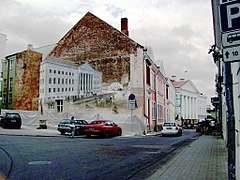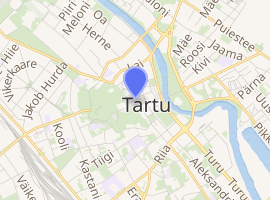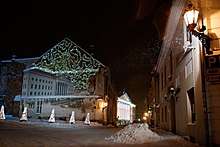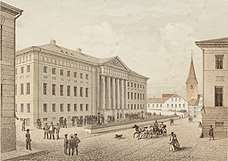Von Bock House
Von Bock House is in Ülikooli Street in Tartu in Estonia. The building is owned by Tartu University, and is on the same street as the university's main building. Von Bock house has a mural of the university's main building on one of its walls.[1]
| Von Bock House | |
|---|---|
 Von Bock House in Ülikooli Street | |

| |
| General information | |
| Address | 16 Ülikooli Street |
| Town or city | Tartu |
| Country | Estonia |
| Coordinates | 58.3806°N 26.7205°E |
| Completed | 1786 |
| Renovated | 2007 |
| Renovation cost | 3m kroons |
| Owner | Christina Wilcke |
| Design and construction | |
| Architect | Johann Heinrich Bartholomäus Walter |
| Renovating team | |
| Architect | Merje Müürisepp |
History
The building was commissioned following the Great Fire of Tartu (then called Dorpat) which consumed the wooden buildings of the city in 1775. The builder's German born architect was Johann Heinrich Bartholomäus Walter who also worked on Tartu Town Hall which was nearby. The house was built for Christina Wilcke and was nominally complete by 1780.[2]
The building is named for Colonel Magnus Johann von Bock who owned the building.[3] The Bock family had their main manor in Saare County.[4] The building was described as being 147 by 45 (Rhein) feet in area. It started with a vaulted basement and a ground floor that was dedicated to service and which was also partially vaulted. The first floor had a large room with an extravagant plastered ceiling designed for entertaining. However the Bock family had agreed for the building to be used by Tartu University. New building work was approved and it was agreed to construct a library, lecture rooms and a place for public debate.[2] The building was adapted in 1783 to 1786.[5]

The new project commissioned artists and decorators who covered the staircase and surrounding areas in a bold black and white check pattern that was said to match the arabesque stucco of the upper floor ceiling. One room was wallpapered with a floral design that also included three large landscape murals. The hall had a white fancy ceiling whilst the walls were covered in another arabesque design around the five large windows with two white tiled stoves to provide heating.[2] The new German speaking University was re-launched and had its new charter was confirmed by Alexander I of Russia in 1802.[6]
M.J. von Bock died in 1807[7] and the converted building was bought by the University of Tartu in 1839. The house has had a series of different roles since then including the University's medical facility, a veterinary school, and the library of the Estonian Learned Society.[3] The learned society had been founded in 1839 with the aim of investigating and improving culture in Estonia. The society's first activity was to create education for the local population.[8]
2007 renovation and another mural

Today the building is still owned by the university and in 2006 to 2007 the building was renovated under the managemement of Merje Müürisepp. Müürisepp had the facade restored to light yellow and the rest of the building painted a dark pink. A vast external mural was constructed on the side of the house. The mural was a reproduction of a lithograph by Louis Hoflinger who had lived in Tartu around 1860.[1] The Art Museum of Estonia has a large collection of his work.[9] The design was prepared by Maarja Roosi. The mural shows the main building of the University of Tartu exactly as it was recorded in 1860 by Hoflinger. It was constructed by students under the supervision of university staff.[1]
The mural was accompanied by an exhibition of photographs that was shown at the windows of the house in 2007. The photographs were arranged by Alan Madisson and featured notable academics from the university.[10]
The renovation of the house was completed at a cost of three million kroons in September 2007. Four years after the renovation the plasterwork of the building developed cracks which seemed to have been caused by subsistence.[5]
This subject of the mural, the University's main building, is further down Ülikooli Street and it is possible to view both the mural and the main building at the same time.[11]
References
- Von Bock House, University of Tartu, retrieved 29 December 2013
- Phenomenological Alma Mater. Borders of the Visible and the Invisible in Heritage Protection, Juban Maiste, 2009, p.195, Tartu University, utlib.ee, retrieved 30 December 2013
- Von Hock House, VisitEstonia.com, retrieved 28 December 2013
- Saare Manor, Estonian Manors, retrieved 29 December 2013
- Pau, Martin (12 December 2012). "Von Bock's House Ripped (in Estonian)". Tartu Postimees.ee. Retrieved 29 December 2013.
- History, Tartu University, trrieved 30 December 2013
- Crl Tenner, T.Viik, aai.ee, retrieved 29 December 2013
- History, Estonian Learned Society, retrieved 28 December 2013
- Louis Hoflinger, Estonian Art Museum, retrieved 31 December 2013
- von Bock house (in Estonian), Tartu University, retrieved 29 December 2013
- Commons:File:Tartu_-_Ülikooli_16.jpg, Ilia, Wikimedia Commons, retrieved 29 December 2012
| Wikimedia Commons has media related to Von Bock house. |